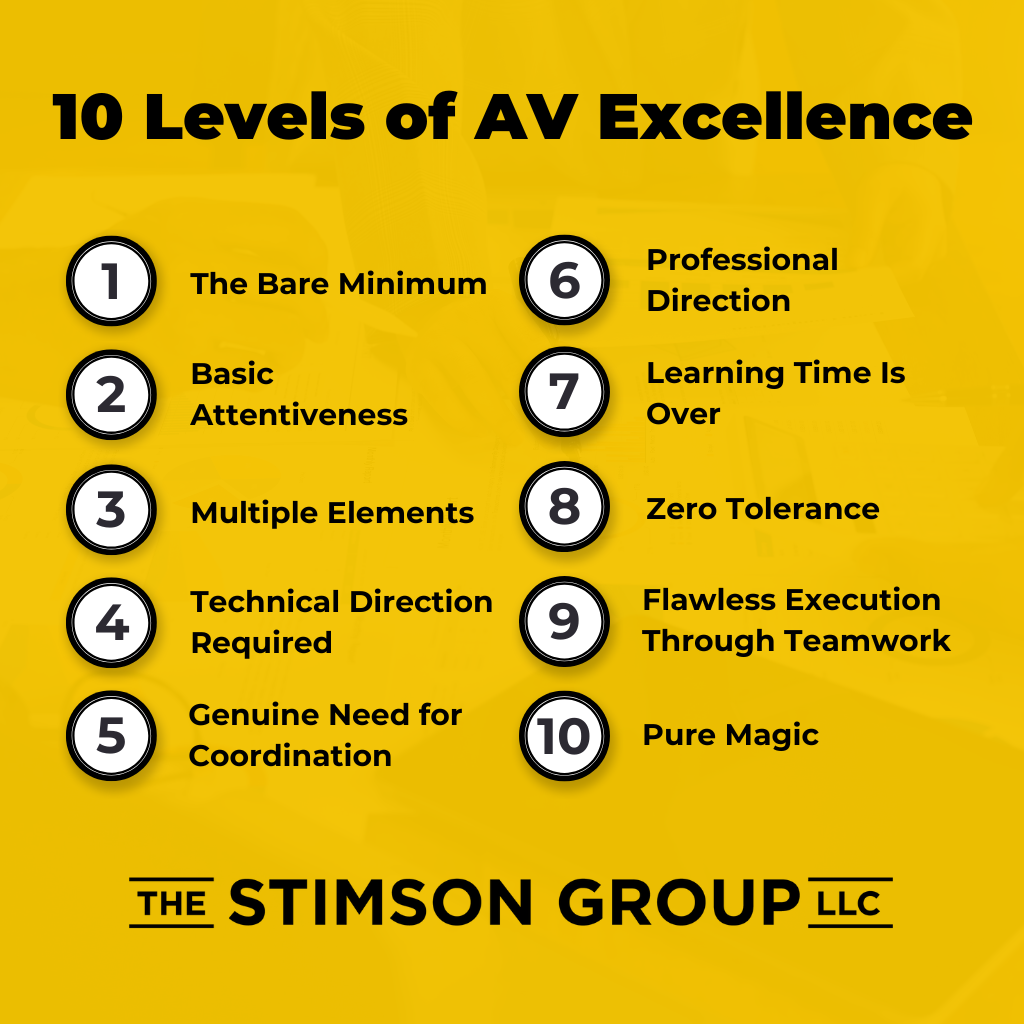
Listen instead on your Monday Morning Drive:
Years ago, when my company was young, one of our owners was out working on a show. We were surrounded by national-level companies doing top-tier work, and we showed up as the projection guys.
Someone approached our owner and asked, “Who are you guys? Where are you from?”
He answered. The person said, “I’ve never heard of you guys. Who’s better than you?”
That question took me years to understand, but when I did, it became a turning point for our business.
Knowing who’s better than you means understanding where your company fits in the industry. That’s why I’ve developed a framework of 10 levels of show excellence.

What Makes a Show?
Not every job is the same. Some are easier than others. But what is a show?
A show happens when we try to move an audience with information, media, or experiences. In AV terms, a show can be as simple as putting a microphone on a stand in front of an audience, connecting a speaker, and turning the mic on and off at the right time.
With that definition in mind, let’s explore the 10 levels of AV shows to help you understand where your company fits — and who’s better than you.

Level 1: The Bare Minimum
This is the speaker-on-a-stick, microphone-on-a-stand show. The presenter might need to wave at the audio person to turn on the mic or point out feedback issues. The operator might leave the mic hot all the time and react slowly to volume changes.
The job gets done — people hear the presenter — but it’s not beautiful or graceful. It’s the bare minimum.
Level 2: Basic Attentiveness
At this level, no one needs to tell you to turn the microphone on or off, fix audio levels, adjust the image on screen, or move cables off the stage. Someone is paying attention to these details.
This seems like the minimum most companies should aspire to, but many struggle to consistently deliver even this level of service.
Level 3: Multiple Elements
Level 3 shows add complexity with multiple technical elements: audio, video, lighting, scenic. Technicians must coordinate across multiple devices or with each other to operate correctly.
Levels 1–3 are what I call “meatball AV.” The mistakes aren’t very costly and are generally easy to dismiss. The client understands they’re getting what they paid for. It may not be perfect, but it’s good enough.
Many companies make good money at Level 3, but our egos often need Level 4 and higher.
Level 4: Technical Direction Required
At Level 4, mistakes start to matter more. The show might need a show caller, but it usually gets by with technical crews directing each other.
If your crew lacks the experience to create seamless transitions, you’ll need a show caller to direct people. Often, a production company will send its producer, project manager, or account executive to fill this role.
For local clients, this is when AV companies start putting their people into unpaid show caller roles as a “value add.” But if your show caller is there to keep the customer from dealing with your crew’s attitude or inability to have customer-facing conversations, you’re maxed out at Level 4.
Level 5: Genuine Need for Coordination
Level 5 actually needs a show caller. Not to compensate for crew inadequacy, but because the content and deliverables expected by the client are more complex. How it’s done matters more, and cues must be coordinated.
The crew is probably experienced enough to make an inexperienced show caller look better. However, if the show caller and crew are operating at the same level, mistakes lead to finger-pointing.
The show caller should always be better than the show crew, but that doesn’t happen consistently.
Level 6: Professional Direction
Look at the show caller. Who hired them? If you hired them, this probably isn’t a Level 6 show.
If you provided the technicians and the show caller, you’re probably working inside an experience bubble. It might be a Level 6 show, but it won’t break through until professional show callers enter the scene.
A professional show caller works with the team to get it right. Rehearsals continue until muscle memory gets the timing right every time.
They don’t work with the crew’s limitations. Instead, they elevate the crew and the show.
Level 7: Learning Time Is Over
After Level 6, OJT (on-the-job-training) is over. If you’re learning, you’re holding back the show.
Show callers on Level 7 shows are pros. They accommodate any inadequacies in the crew professionally, but the client will hear about it later. They also accommodate talent issues: CEOs who need coaching or performers who make mistakes.
Crews on these shows need to know what to do when equipment fails or cues are missed. They need to understand what other departments are doing and anticipate specific problems before they happen.
Level 8: Zero Tolerance
A crew member who cannot follow protocol or makes mistakes will be replaced immediately. There’s zero tolerance for poor fit, and expectations are very high.
I’ve seen vendors replaced on Level 8 shows in the middle of load-in.
Level 9: Flawless Execution Through Teamwork
There’s no room for mistakes, though they will happen. What matters is the unspoken team response behind the show direction. Everybody knows what to do.
When you watch a live television broadcast of a carefully choreographed event, the expectation is perfection.
Even Level 9 touring crews can’t perform complex shows in multiple venues without occasional errors, but their professionalism in working through problems is phenomenal. Nothing stops the show.
Level 10: Pure Magic
There are no planned Level 10 shows. They happen, but no one knows they’re on a Level 10 show until it’s over.
It’s magic that occurs when everybody rises to their highest level of contribution. Every supplier, technician, and on-stage talent exceeds all expectations. Level 10 shows happen, but they’re rare.
Know Where You Fit
Some companies get opportunities to work on projects beyond their current capabilities. We call this “punching above your weight.” When this happens, be aware of it so you can compensate.
Sometimes a buyer sees potential in you worth trying out. They put you in situations where you won’t fail but might need support. This can lead to bigger opportunities.
When a company you’ve been pursuing for a long time hires you, don’t assume you’re the best option. Maybe no one better was available, or maybe your account manager oversold your capabilities.
Show up humble and be willing to learn.
Outgrow Your League: The Action Plan
- Hire better show callers than you think you need. Crews don’t learn to improve in a bubble — they need outside expertise. Show callers can elevate your entire team.
- Bring in better technicians than you have. Learning happens when you work with more experienced technicians. The best technicians working Level 8 and 9 shows are almost always freelancers.
- Know who’s better than you. I can tell I’m dealing with a mid-tier AV company when their technicians think no one is better than them and believe freelancers aren’t as good as their regular team. If you don’t recognize who’s better than you, you’re the problem.
This industry is full of great opportunities, but self-awareness will take you far. See what’s happening around you, identify what you can aspire to, and find the path to get there. Learn from people better than you instead of remaining insular.
Get out there and do bigger, better shows. Just make sure you belong there.





Leave a Reply